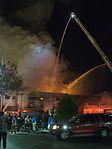Sausal Creek (Alameda County)
Berkeley HillsGeography of Oakland, CaliforniaRivers of Alameda County, CaliforniaRivers of Northern CaliforniaTributaries of San Francisco Bay ... and 1 more
Works Progress Administration in California
Sausal Creek, 3.1 miles (5.0 km) long, is one of the principal creeks in Oakland, California. The creek derives its name from the Spanish word for willow grove (sausal). Native arroyo willows were once common along its banks. Efforts are underway to restore the willows and the creek itself. A volunteer group, Friends of Sausal Creek, helps remove invasive species and plant native species. Some of the invasive species in the Sausal Creek watershed include Monterey pine trees, ivy, French broom, and wild mustard. The friends run workdays at the Scout Hut in Dimond Park on Saturdays throughout the year.
Excerpt from the Wikipedia article Sausal Creek (Alameda County) (License: CC BY-SA 3.0, Authors).Sausal Creek (Alameda County)
East 15th Street, Oakland
Geographical coordinates (GPS) Address Nearby Places Show on map
Geographical coordinates (GPS)
| Latitude | Longitude |
|---|---|
| N 37.779166666667 ° | E -122.22722222222 ° |
Address
East 15th Street 3007
94601 Oakland
California, United States
Open on Google Maps





